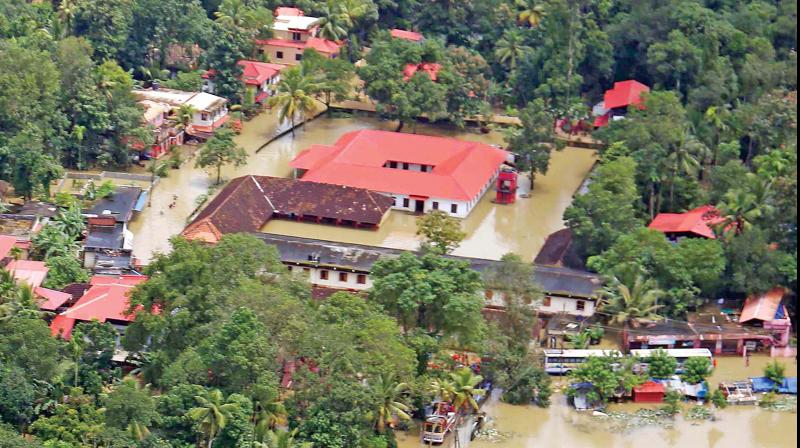Climate doomsday pundits could be correct after all

Kerala may be barking up the wrong tree, or should one say the wrong dam? The Mullaiperiyar dam, an ingenious creation of the British engineer Pennicuick, is being targeted at a time of plenty as well. The irony is it has become a symbol of discord even at a time when the ancient structure proved its ability to hold 142 feet level of water. Maybe, it is the contentious environment of the day that is to blame. The issue, however, must be viewed with sympathy as Kerala has been devastated, even if it was only done in by a disaster that was presaged with plenty of warnings having been given by scientists and environmentalists.
The facts bear out that Tamil Nadu has a clear case as well as a clear conscience with regard to Mullaiperiyar. The discharge from the TN-operated dam was just about 6 tmc feet of water as compared to the 36 tmc feet that the Idukki and Idamalayar dams sent rushing downstream to overwhelm Aluva and Ernakulam-Kochi in the maximum weeks of the disaster, which were the second and third weeks of August. The enormity of 40-plus rivers overflowing their banks is a biblical spectacle of a deluge that proved as frightening as the effect of Hurricane Katrina on New Orleans.
What such calamities reveal is there are many more to come and the one to blame is mankind. A warmer world will see more and more extreme events. This is a theme that has often repeated itself as storms of every possible category to flooding, landslides and fires ravage the planet on a routine basis these days. You don’t need any silly logic like those of some bakhts who blamed the Kerala floods on a bachelor god’s anger when we know that man has helped these events over the last 100 years with just his selfish presence on the planet in increasing numbers that have topped seven billion and counting.
The industrial world could be blamed for all the damage caused by global warming as it expanded in the 19thand 20thcenturies. However, we are also to blame for climate change by sheer unplanned expansion of living spaces as forests have been denuded to try and satisfy an insatiable greed, a fact that is particularly relevant to the ecology of the precious Western Ghats whose biodiversity was the pride of South India. The imagery of palm-lined beaches and nature and native cures in spas has been an excellent driver of tourism for ‘God’s own country’. Only now are questions being asked whether excesses in this segment are beginning to tell.
The point is the dangers of unplanned expansion without sparing a thought to disturbing the ecological balance were well brought out in the Gadgil and Kasturirangan reports on the ecology of the Western Ghats. The United Nations disaster response expert Muralee Thummarukudy and Madhav Gadgil had warned in their 2011 reports that a mega-monsoon was inevitable and for which the state was ill-prepared. Muralee is quoted as having said that he was not at all proud that his doomsday forecast had proved right. The push for development may have bulldozed all such concerns.
A very bitter Gadgil is quoted as saying “Unfortunately, our state governments are in collusion with vested interests that do not want any environmental laws to be implemented. Our recommendations would have been accepted in any law-abiding society. But we have a lawless society and extremely poor governance.” That rings very true when the impact of the disaster strikes in the images of rushing water and the devastation it leaves in its wake we have had an overdose in the past few weeks. It is a very sad moment to see lives wrecked beyond easy redemption as thousands of dwellings have been damaged and the pain and the costs involved in rebuilding lives are beyond description.
The other problem that environmentalists have often stressed is the apathy towards coastal regulations. India has such a long coastline from West Bengal to Gujarat in peninsular India that unplanned development extending for thousands of kilometres is bound to prove disastrous. It appears the march of private capital and the commerce it spins off in the hunt for profits is unstoppable. And then there is the sand mafia that has been supplying a precious building resource for developers and builders all over the country. The ecological damage they have caused by mining sand from rivers is still being assessed.
In the final analysis, we are incapable of learning from history. A few months on, life will be nearer normal and the worst of the flooding experience will have been forgotten. It will be back to business as usual as 1.3 billion people will be living off the finite resources of the country. Maybe, looking at all this, it would be a good idea if man were to colonise Mars in order to survive the climate apocalypse that might make Earth uninhabitable, as also foretold in the puranas and their definition of the yugas. The inexorable march of destruction might jeopardise the whole of mankind some day in the not too impossibly far future. Is Kali yuga coming sooner than predicted?
(R Mohan is the Resident Editor of Chennai and Tamil Nadu editions of Deccam Chronicle)

